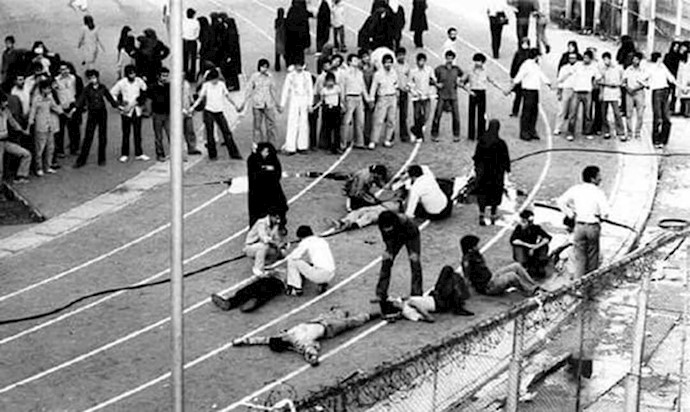Analysis by PMOI/MEK
Iran, February 7, 2020—Thirty-eight years ago, on February 8, 1981, Mousa Khiabani, one of the prominent leaders of the People’s Mojahedin Organization of Iran (PMOI/MEK) was killed by terrorists of the Revolutionary Guards (IRGC). Two years earlier, he had warned about the threat of state-backed terrorism in Iran and the founders of the IRGC who were serving the young religious fascism under the cover of club-wielders.
Mousa Khiabani was born in 1947 in Tabriz, northwestern Iran. After getting his diploma in his hometown, he continued his education and studied physics at the University of Tehran. In September 1971, he was arrested due to his activities with the PMOI/MEK. Later in 1972, Khiabani was sentenced to life in prison but was released in 1979 following the people’s demands for releasing political prisoners during the Iranian revolution.
Since 1979, Khiabani along with Massoud Rajavi, the leader of the PMOI/MEK, became renowned as being among the most important critics of the oppressive measures of Ruhollah Khomeini’s regime. They were seizing any opportunity to expose the prospected outcome of mullahs’ functions who openly tried to impound all means of ruling.
Notably, Khiabani was one of PMOI/MEK candidates for the 1980 parliamentary elections. However, the pro-Khomeini government barred all PMOI/MEK candidates from the entering the first parliament after the 1979 revolution. At the time, PMOI/MEK officials provided hundreds of documents that revealed widespread fraud by pro-Khomeini Hezbollahi elements. But the Khomeini-controlled Ministry of Interior Affairs rejected documents and, aligning on the regime’s path, preventing the PMOI/MEK from being represented in the parliament.
The PMOI/MEK officials, including Mousa Khiabani, time and again issued warnings about former thugs who were recently absorbed in the religious regime. The thugs, who were notoriously known as “club-wielders,” were the regime’s tool for suppressing and terrorizing the society. In June 1981, Mousa Khiabani in an interview explicitly warned about the negative impact of club-wielders’ movement on social security and Iran’s political fate. “During the past 16 months, this issue has genuinely reached a hazardous point. Club-wielders have now become a specific threat to the security of our society and the political future of our country,” he said.

PMOIMEK members injured by club-wielders of the Iranian regime in a peaceful gathering
Mousa Khiabani also declared that those club-wielders will soon begin to attack and search people’s homes, which eventually took place in the 1980s. “If they are entering bookstores today, who can guarantee they won’t enter the people’s homes in the future?” Khiabani asked. More recently, on December 1, 2019, Ahmad Khatami, Tehran’s leader of Friday prayer, vowed the regime will carry out house-to-house searches to eradicate the protests as it did in the 1980s against the PMOI/MEK.

Ahmad Khatami, a senior cleric, calls for the identification and arrest of protesters in the same style as the regime did in the 1980s
Mousa Khiabani also warned about the establishing and organizing of terror squads under the cover of club-wielders’ movement. He emphasized that this move would result in blind terrorism. “This [club-wielders’] movement will cause blind terrorism in its evolution. We are precisely informed that a terrorist wing will emerge through club-wielders’ groups. We have information pertaining to that some of the club-wielders have been organized in terrorist groups. Therefore, the phenomenon of [club-wielders] should be seriously confronted,” Khiabani cautioned in 1980.
The background of the IRGC and establishment and functions of the Quds Force (IRGC-QF) are the best testament to Khiabani’s warnings. In this respect, in addition to orchestrating hundreds of terror plots against Iranian dissidents inside the country and abroad, the IRGC and IRGC-QF are responsible for the killing of hundreds of thousands of innocent people across the globe and particularly in the Middle East. However, due to the appeasement policy of the West these brutal butchers who have the blood of many Iranians and foreign citizens on their hand, have yet to be held accountable for their crimes.
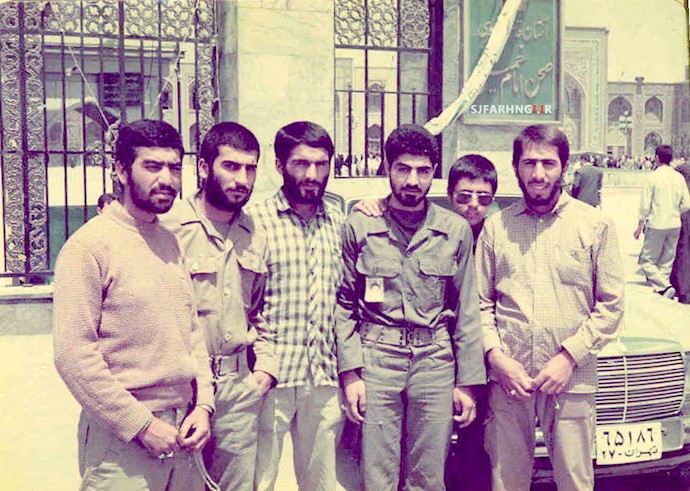
Qasem Soleimani (Third from right), now-dead Chief of terrorist Quds Force in 1980 was one of the regime's club-wielders at the beginning
Several highlights of the crimes committed by the IRGC and IRGC-QF include the following:
1. Arbitrary arrest, torture, and execution of hundreds of thousands of PMOI/MEK members, supporters, and their family members, including the massacre of more than 30,000 political prisoners, mostly members, and supporters of the PMOI/MEK, in the summer of 1988.
2. The IRGC’s scheduled attempt for coup d'état by using Iran-backed extremists under the banner of “the Islamic Front for the Liberation of Bahrain” in 1981
3. Bomb attacks against the U.S. and French embassies in Kuwait through Abu-Mahdi al-Muhandis, in December 1983
4. A series of bomb attacks in Paris between December 1985 and September 1986, resulting in 13 killed and 285 wounded. The attacks ended when the French government acquiesced to the terrorists’ demands for expelling the PMOI/MEK leader from France and freeing the Iranian regime-linked terrorists Anis Naccache and his group. Remarkably, Naccache and his partners were arrested in a failed attempt to assassinate Shahpour Bakhtiar, the last prime minister of the Shah regime, in 1991. Bakhtiar was later murdered by another terror cell of the Iranian regime according to the memoirs of IRGC founder Mohsen Rafighdust.
5. The assassination and abduction of more than 80 political activists, writers, poets, translators, and ordinary citizens between 1988-98, which became known as the “chain murders.” Several victims including:
– Abdul Rahman Ghassemlou, the leader of the Kurdistan Democratic Party, in Vienna, Austria, in July 1989
– Shapour Bakhtiar, the last Prime Minister of the Shah regime, in Suresnes, France, in August 1991
– Kazem Rajavi, a member of the National Council of Resistance of Iran (NCRI), and brother of Iranian opposition leader Massoud Rajavi, in Coppet, Switzerland, in April 1990
– Fereydoun Farrokhzad in Bonn, Germany, in August 1992
– Iranian-Kurdish opposition leaders in Berlin, Germany, in September 1992
– Mohammad Hossein Naghdi, NCRI member, in Rome, Italy, in March 1993
– Bishop Haik Hovsepian Mehr in suburb Tehran, in January 1994
– Priest Mehdi Dibaj in the western Tehran, in June 1994
– Bishop Tedhis Mikailian in Tehran, in July 1994
– Dariush Forouhar and his wife Parvaneh in Tehran in November 1998
6. A bomb attack on the shrine of Ali al-Reza, the eighth Imam of Shiite Muslims, in Mashhad, Iran, which resulted in at least 25 dead and around 70 injuries among ordinary pilgrims, in June 1994
7. The bomb attack on AMIA building in Buenos Aires, Argentina, on 18 July 1994, which killed 85 people and injured hundreds
8. The assassination of Zahra Rajabi, NCRI member, in Istanbul, Turkey, in February 1996
9. Bomb attack on Khobar Towers in Saudi Arabia, in June 1996, which killed 20 people
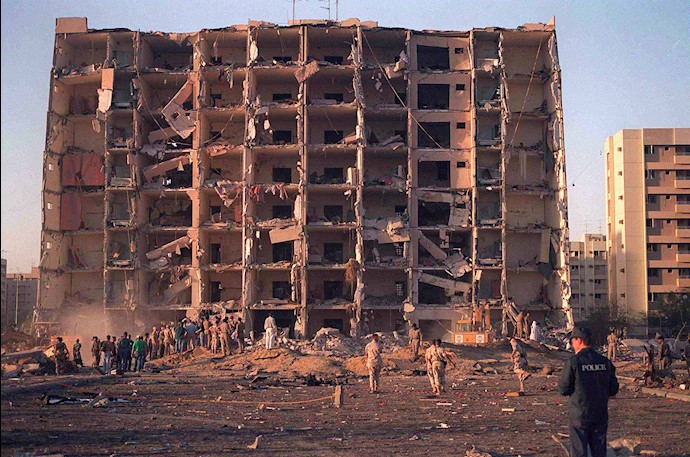
Khobar Towers bombing in Dhahran, Saudi Arabia. On June 25, 1996, a terrorist truck bomb exploded outside the northern perimeter of the U.S. portion of the Khobar Towers housing complex.
10. Heavy attack on PMOI/MEK bases across in Iraq with 1,000 missiles according to remarks by then-chief of IRGC Yahya Rahim Safavi, in April 2001
11. Masterminding a religious genocide in Iraq through Iranian regime-backed militias against Sunnis between 2003-2009, and a bomb attack on the shrine of al-Askari, the eleventh Shiite Imam, in Samarra, in February 2006
12. Kidnaping two members of PMOI/MEK members Hossein Puyan and Mohammad Ali Zahedi in Baghdad, in August 2006
13. Frequent attacks against PMOI/MEK in Iraq by using local mercenaries like Kata’ib Hezbollah group, Jeish al-Mokhtar, etc. between 2009-2016, which resulted in around 180 killed and hundreds injured. The attacks include five missile attacks, and a bloody raid on September 1, 2013. The Iranian regime-backed forces fired coupe de grace shots to dozens of captives and the wounded lying on the beds of camp’s medical center.
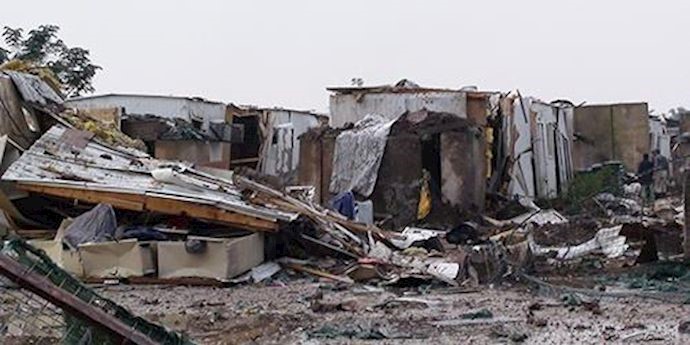
IRGC-backed groups conducted several attacks against MEK members in camps Ashraf and Liberty in Iraq, killing more than 150 MEK members and wounding thousands of others
14. A foiled assassination plot against then-Saudi Arabia Ambassador to the U.S. Adel al-Jubeir at a restaurant in Washington D.C., in October 2011
15. Bomb attack against an Israeli diplomat in New Delhi, India, wounding one embassy staff member, a local employee, and two passers-by, in February 2012. A day later, The Thai government arrested several Iranian nationals who were supported by the Iranian regime and charged the for similar attacks in Thailand
16. Two IRGC-QF officers were arrested while being in possession of 15 kilograms of a powdery substance. They were involved in foiled bomb attacks against the United States, Israeli, Saudi, or British targets in Kenya in June 2012. Notably, the Iranian regime’s Ambassador to Kenya Hadi Farajvand has been caught up in an investigation about a plot to free two terror suspects from police custody in February 2019
Sen. Robert Torricelli:
What happened on June 30 was part of a pattern & not an isolated event.
Weeks prior to that terrorists south to plant a bomb against #Iran'ian refugees (MEK members) in Albania.#ExpelIranDiplomatTerrorists pic.twitter.com/NIVwgmFGCP— People's Mojahedin Organization of Iran (PMOI/MEK) (@Mojahedineng) October 4, 2018
17. A foiled bomb attack against the PMOI/MEK Nowruz celebration in Tirana, Albania, in March 2018. Notably, in December 2018, the Albanian government expelled four diplomat-terrorists of the Iranian regime from this country, including the ambassador and his first secretary. In October 2019, the Director of State Police in a press conference shed light on the new scope of the Iranian regime’s terrorist conspiracy on its soil.
18. A foiled bomb attack on the annual gathering of the National Council of Resistance of Iran (NCRI) in France in June 2018. The gathering was attended by NCRI President-elect Maryam Rajavi, 600 prominent figures from the U.S., European Union, Middle East, and North Africa, in addition to tens of thousands of Iranians. In a coordinated counter-terrorism operation, the German law-enforcement arrested senior Iranian diplomat Assadollah Assadi for delivering 500 grams of the explosive substance to the operatives. Belgian security forces also made arrests on the same day. Later, the French government also froze the assets of the deputy Minister of Intelligence and Security (MOIS) in its country.
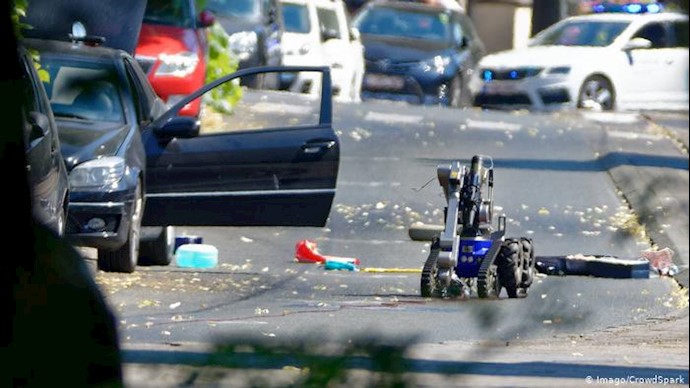
In June 2018, IRGC agents conducted a failed bombing plot against a large gathering of NCRI supporters in Paris, France.
19. It is worth reminding that the Iranian regime and in particular the IRGC have a notorious background in kidnapping foreign citizens and troops. “Look at how the IRGC generates funds. The IRGC detains a spy like Jason Rezaian. The U.S. pleads for him to be released. We say: No, you have to pay for him. Our government gets paid $1.7 billion to hand over this spy. Thus, by detaining just one spy, the IRGC earns the equivalents of the $1-2 billion it was supposed to receive from the government budget,” Hassan Abbassi, a former IRGC commander and head of Yaghin think-tank said in January 2020.
Additionally, the IRGC is in charge of the nuclear bomb-making projects of the Iranian regime and many other crimes that aren’t mentioned in this list. In conclusion, it is worth reminding a prominent quote of Mousa Khiabani who heralded the victory of freedom-loving people and the overthrow of the theocratic regime in his speech in Tehran. “Believe, the future belongs to [freedom-loving] people, the medieval forces will eliminate,” Mousa Khiabani told PMOI/MEK supporters in a meeting in January 1980.


